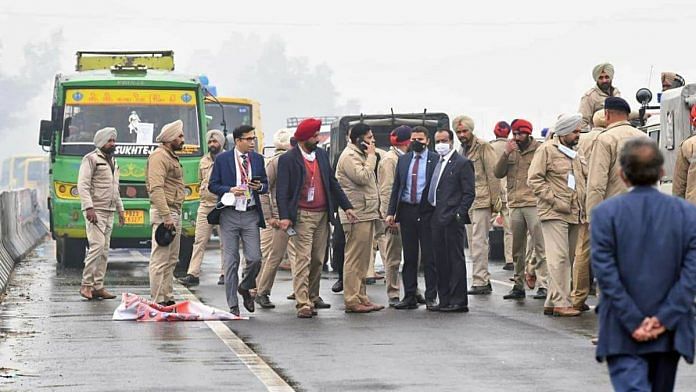New Delhi: As Prime Minister Narendra Modi’s scheduled visit to Punjab’s Ferozepur was cancelled Wednesday after what the Ministry of Home Affairs called a ‘major security breach’, sources in the security agencies told ThePrint that the lapse was a result of either “lack of communication” between the agencies, “incompetence of the state police” or “lack of preparedness” by the Special Protection Group, responsible for the PM’s security.
Modi was forced to turn back after protesting farmers blocked the road leading to Ferozepur. The PM was left stuck on a flyover for 15-20 minutes.
While the MHA sought a report from the Punjab government on the “major lapse”, accusing the state police of not putting “sufficient deployment”, Punjab Chief Minister Charanjit Singh Channi claimed that all arrangements were in place and that the PM’s plan to take the land route instead of the chopper was “too sudden for his government to make alternative arrangements”.
The sources in the security agencies, however, told ThePrint that going by the rule book, there is always a “contingency plan”— which has a land route in case the PM is unable to take the chopper for any reason. And this plan is prepared with the local police, local intelligence unit and other security units on board.
ThePrint explains what is the role of the Special Protection Group, the state police and other security agencies during a prime minister’s movement, and what all goes into ensuring a smooth, secure visit.
Also read: PM cuts short Punjab visit after ‘major security breach’ on road, MHA wants answers from state
‘Contingency plan’
According to a retired SPG officer, who did not wish to be identified, there is always a “contingency plan”, or an alternative to the existing plan, which is drawn for every visit of the prime minister.
“If the original plan is to go by a chopper, then an alternate land route is also charted out in case of a contingency. What if there is a technical issue in the chopper, or the weather is bad? So, a land route is always an option,” the retired officer said. “This land route is discussed with the local police and other security agencies in advance and they are expected to make the deployments and sanitise the route well in time.”
He, however, said that it is the SPG that gives a go-ahead for the alternative plan, only after “thorough checks” and after being assured that a smooth passage will be provided.
Before the PM’s visit, there is an Advance Security Liaison (ASL) drill, in which the SPG meets with the local police, officials of the local state intelligence, officials of the Intelligence Bureau and other security units to discuss issues like anti-sabotage checking, sanitising the venue and the roads (leading to the venue) and security deployment on the way, the retired officer explained.
A second officer in the SPG said even municipal corporations are roped in to check the venue and the roads. A certificate to ensure that the stage on which the PM will stand and address the crowd is robust enough or not is also sought.
The ASL drill is held two days in advance for election rallies, but 10-15 days in advance for planned events.
Modi, who landed at Bathinda Wednesday, was to leave for the National Martyrs Memorial at Hussainiwala by helicopter, but the plan had to be changed due to rain and poor visibility and he chose to leave by road. This is when his convoy was stopped on a flyover, where it stood for over 15-20 minutes, after protesting farmers blocked the road leading to Ferozepur.
‘Why give clearance when everyone knew about protests?’
The retired officer also questioned the SPG’s decision to go ahead with the land route.
“It definitely is a big lapse, but why did the SPG allow the movement, knowing that the farmers have been agitating and blocking roads? This was not something which was not known. Why take that risk?” the former officer asked. “Why was the PM allowed to leave Bathinda without prior checks?”
A second retired SPG officer said when any PM travels by road, a team of SPG literally clamps the location. It coordinates with all the agencies, including the IB, for inputs as the PM’s security is “paramount” and his movement should have “no disruptions”.
“From the clearance of the road to the checking of all bridges and underpasses on the way — there is a checklist for everything. The list of deployment of policemen who will be deputed on the road is also checked. Deployment is done on the entire route to ensure there are no disruptions,” the second retired officer said.
“So, either the contingency plan was not drawn out properly or the intelligence units did not convey the possible threats. Whatever may be the case, the road journey should not have begun without being sure that everything was under control — in this case, everyone knew about the ongoing protests, it was no secret and it should not have been ignored,” he also said.
(Edited by Saikat Niyogi)
Also read: Amit Shah lashes out at Cong govt in Punjab over ‘security lapse’ during PM’s visit to state



